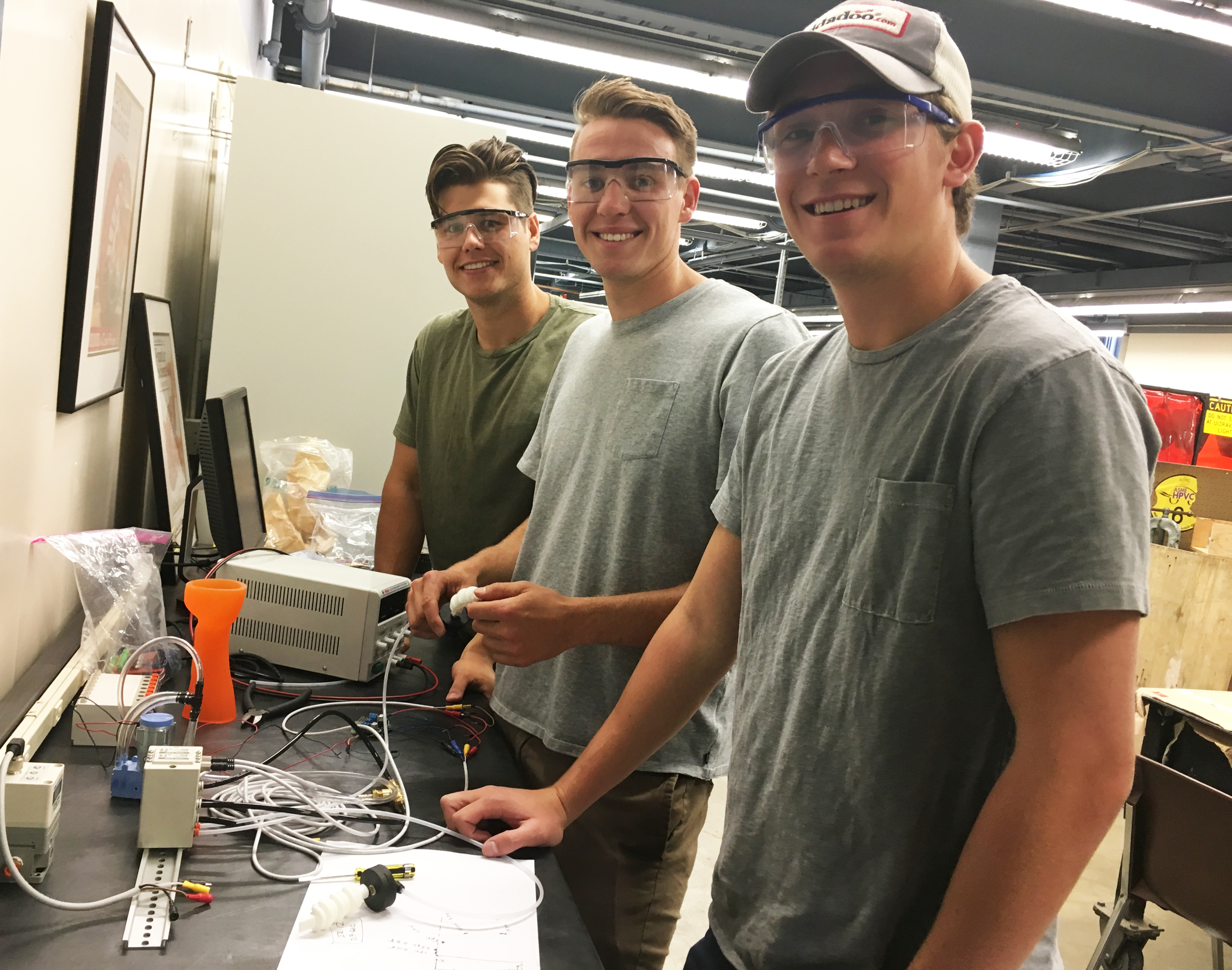
Getting a Grasp on Soft Robotics
Heidi Williams
Futurists contend that rather than worrying about robots taking over all of our jobs, we should embrace a new reality in which humans work alongside automatons. But a couple of obstacles stand in the way of adopting this vision. One is the rigidity of metal robots—their inflexible gripping mechanisms and their inability to pick up and manipulate ordinary objects. Another problem is workers’ fear of being injured by hulking metal machines in their work environment. A solution to these problems: flexible, soft robots made entirely from pliable materials that can grip a range of items but won’t hurt co-workers in the event of a malfunction.
Soft robotics is a nascent field, but one with great potential, and mechanical engineering seniors Zachary Kisner, David Leonardo, and Christopher Szigeti are moving the needle on its adoption with their design and production of a 3D-printed, pneumatically controlled, soft robotic hand for use in manufacturing. The teammates bring a range of experience beyond the classroom to their project. Leonardo interned at a robotics company, Szigeti had internships in design work and product development, and for the past few summers Kisner worked at Molecule, a Concord, California, company specializing in chemistries and nanofluids for 3D printing and other markets. Molecule provided all the materials for their project, allowed access to its 3D printers, and—along with their academic advisors, Mechanical Engineering Assistant Professors Panthea Sepehrband and Michael Taylor—assisted in fleshing out the team’s ideas and determining what their robotic hand would do. Kisner reported, “The goal was to have a product that could pick up an apple or a pill, demonstrating its ability to adapt to different weights and sizes.”
With the project defined, the seniors began researching soft robotics and what applications are currently available. “This field is so new, there’s not a lot of information out there,” said Leonardo. “There are only about two industry research labs, one company, and a few college research labs working on this, so finding something similar to what we wanted to do was challenging. We had to go out on our own path.”
"Our differentiator is that we’re 3D printing our device,” said Kisner. “Other devices using molded materials aren’t as functional. Printing the components using fluid resin allows us to create more geometries, enabling more movement of the hand.” As another bonus, 3D printing allows for rapid prototyping. “We can print five to ten iterations in an afternoon,” said Leonardo. That function came in handy (no pun intended) as the team experimented with the printer settings and curing times that produced the most successful results.
In addition to the 3D printing aspect of the project, the team also designed hand and wrist movement geometries in 3D modeling software, and created a pneumatic control system in which a flexible tube mimicking a muscle is engaged by compressed air moved through a series of valves. “The control system involves more electrical engineering than mechanical, so we had to learn about the regulators, electronic components, and software to figure out how to achieve different motions by adjusting the air pressure,” said Szigeti.
By late March, the team had successfully printed a gripper and three fingers, designed the control system, and finalized a prototyped thumb. “It’s really cool to see how far we’ve come,” Szigeti said. “Other examples we’d found in our research were just showing a proof of concept but had no functional purpose. To prototype an actual, functional soft robot that could work side by side with humans in the agriculture or pharmaceutical industry feels really good.”
“And,” Kisner added, “if it were to hit someone, it would be like being hit by a balloon!”
“The beauty of working on a project of this scope,” said Leonardo, “is that a lot of it is beyond our discipline or what we’ve learned in class. We’ve been forced to learn a lot. It’s been a really good experience.”
After graduation, the three plan to start careers in product development or robotics. “Having worked on this project, we have a pretty good grasp on the industry,” said Kisner, managing to keep a straight face.